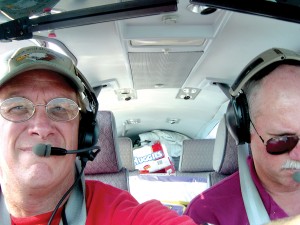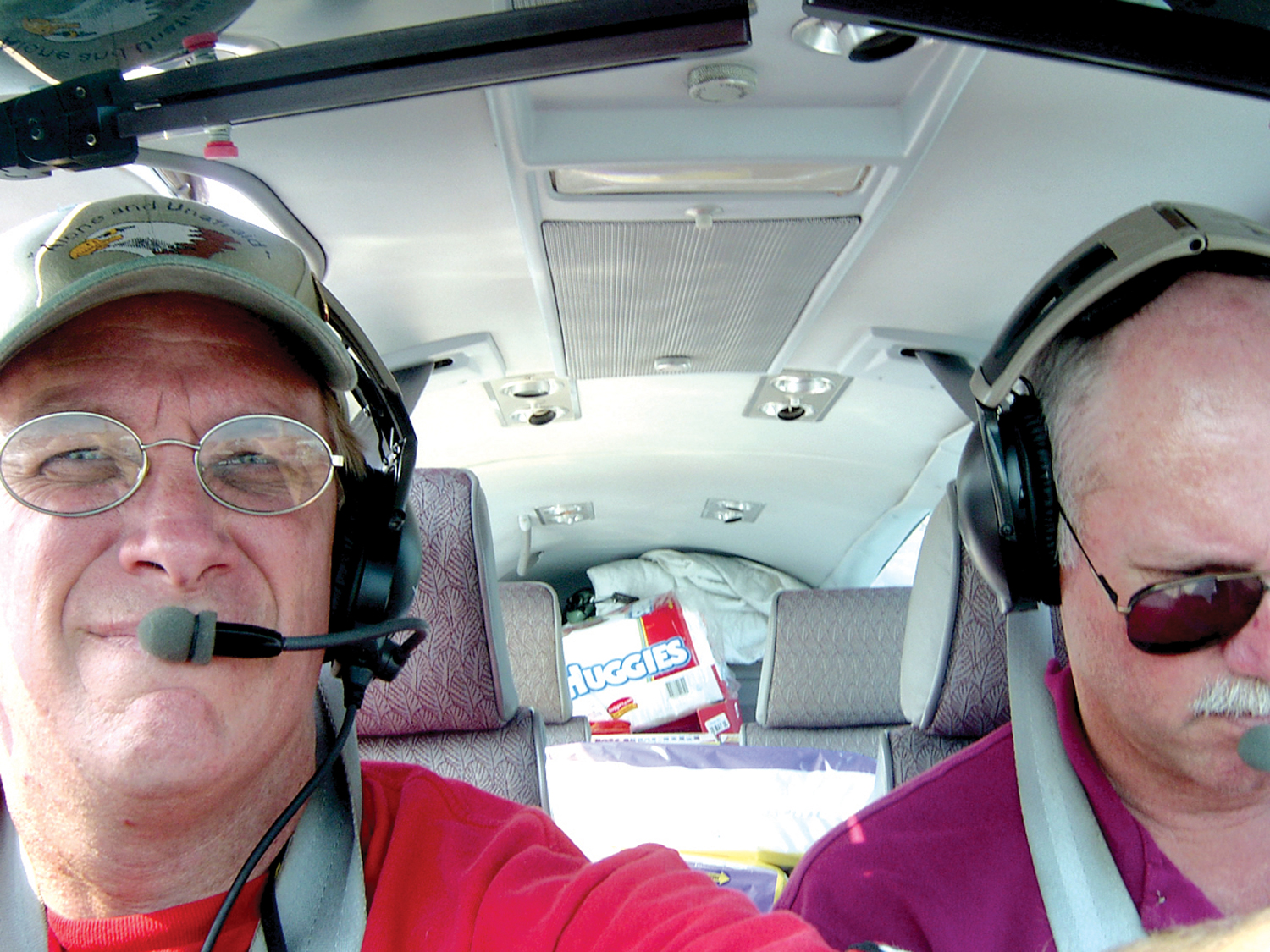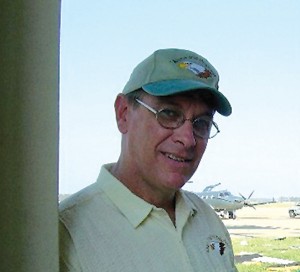By S. Clayton Moore

L to R: Pat Shaub and Ken Wittekiend have transported food, water and baby supplies to hurricane-ravaged Louisiana.
Ken Wittekiend and Pat Shaub of Eagle Training Solutions have a motto: “Alone and Unafraid.” That’s the point that these two professional trainers want their student pilots to get to when flying in the instrument environment.
The veteran flight instructors from Burnet, Texas, formed their company in 2005 with the specific goal of providing what they call the “missing link”–that gap of expertise between the new private pilot with an instrument rating and the seasoned professional pilot.
“We realized that we’re both good not just in training people on how to fly stick and rudder but also in training people who are already rated who want to improve their instrument skills,” Shaub said.
To that end, Wittekiend and Shaub have developed a series of seminars and training sessions on mastering the instrument flight rules environment, ranging from a two-hour introductory seminar they provide for free as a Federal Aviation Administration safety program to a two-day, 12-hour total immersion that allows the instructor to spend quality time with each student.
Their free single pilot IFR seminar covers several basic concepts of that environment including selecting equipment, tips for better community skills, creating a plan for instrument currency and ways to use GPS more effectively.
The advanced seminar runs $495 per student and encompasses all aspects of planning and executing a trip in instrument meteorological conditions. It teaches “real world” experience and shows pilots how to stay truly current, not just legally current, in instrument flying.
To extend the instruction further, they also often provide one-on-one training in both simulators and in the customer’s own aircraft. The basic idea is to create pilots who are able to fly “alone and unafraid,” a motto that former military instructor Pat Shaub borrowed from the old reconnaissance pilot phrase, “alone, unarmed and unafraid.”
“Flying alone and unafraid in the clouds isn’t something that most instrument pilots do,” Shaub said. “They get their instrument rating but they’re a bit afraid to go up in the clouds, and after a while they let their instrument rating lapse. These are pilots who are organized enough to get their rating but smart enough to realize they don’t know how to fly confidently on instruments all by themselves. We get them to the point where they’re really comfortable flying IFR, which is a safer way to fly.”
Although they work with a wide range of pilots, the pair tends to target their program for owner-operators and other pilots using their aircraft for multiple uses.
“We really aim this effort not at the professional who is being paid to fly but at the business owner, the fellow who has his Bonanza or Cirrus who is flying for pleasure as well as business,” Wittekiend explained. “These are the guys who are flying a lot and using it as a travel tool. They’re the people who are most in need of what we have to offer.”
However, the range of diversity surprises even the instructors from time to time.
“We’re in the cockpit every day flying with students,” Shaub said. “Some of them are the sweaty 19-year-olds who want to be airline pilots but most of them are guys closer to our age who now have the wherewithal and the time to learn how to fly. Most of our private pilot candidates are people in their 50s but I trained one guy last week who is 70 and wants to learn to fly.”
Wittekiend and Shaub are able to provide a comprehensive training program that encompasses a wide range of experience due to their own diverse backgrounds.
Ken Wittekiend began flying in 1970 while attending the University of Texas at Austin, when he purchased a 1946 Piper J-3 Cub with no brakes and no electrical system. He continued to fly through a career in retail marketing and advertising where he honed his business expertise. In 1995, he purchased a 1976 Beechcraft Bonanza he still flies today.
“Ken and I both came to a turning point in our lives around the same time,” Shaub said of his partner. “He liked being a flight instructor when he was a kid and so did I, so we’ve kind of come back around full circle. He’s an entrepreneur and a businessman but he also has a huge heart.”
Pat Shaub brings in both military and civilian expertise to the business. He started flying light training airplanes in Houston and joined the Marines after graduating from the University of Houston. In the military, Shaub was a pilot, safety officer and instructor in the CH-53 Sea Stallion. He was later promoted to instrument and tactics instructor in the Naval Air Training Command in the UH-1 E&L model Huey and the TH-57C Sea Ranger helicopters.
“I really wanted to be a Marine fighter pilot,” Shaub admitted. “But a friend of mine was killed in Vietnam doing a medivac in a helicopter and I decided I liked the idea of saving lives a whole lot better than taking them.”
That idea stayed with Shaub as he left active duty in 1987 and moved back to Texas. He flew for some time with the Texas Army National Guard in the OH-58 reconnaissance helicopter and the AH-1S Cobra until his retirement from the guard in 1997. He also stumbled into a brief experience flying Russian military helicopters and brokering parts to the U.S. military. He then moved on to serve as the director of aviation services for the Texas Aeronautics Commission before forming an air ambulance company in central Texas.
“My older brother always accused me of never having a job because I’ve always done what I love and gotten paid for it,” Shaub laughed. “Flying is what I love to do and I’ve been doing it since I was a high school senior.”
That diversity of experience, combined with a passion for teaching, has served Eagle Training Solutions well.
“We do similar things in some ways, and in some we’re quite different,” Wittekiend observed. “I think it makes for a nice marriage, if you will, because we have a broader perspective on how to teach students than we would individually. He brings techniques that come out of his military background and I bring concepts and ideas that I’ve developed through these years of teaching people.”
Although both pilots are very easy-going and considerate trainers, they recognize the life-and-death nature of the subject they teach so well.
“Flying visual, you’re out there all by yourself,” Shaub warned. “No one is paying attention for you, calling traffic for you, or giving you visual routing. A lot of times you have pilots out there flying under visual flight rules when there aren’t visual conditions.”
Shaub and Wittekiend have trained about 75 clients since they opened last year and they intend to expand. They’re developing several new seminars including “GPS in the IFR Environment,” and continue to hold classes throughout Texas and the greater Midwest. They hope to hire experienced professionals like themselves to use as contractors to spread the word about aviation safety, a subject that’s near and dear to their hearts.
“I think there’s a real need for this kind of additional training and I think we bring a very practical perspective to it,” Wittekiend said. “We try hard to look at it from the pilot’s perspective, the guy who is out there slogging it out in the system every day. We just want to help them build the knowledge and skills to be safe and competent out there.”
Angels in America
Shaub and Wittekiend, who both fly missions for Angel Flight, have also done a lot lately to bring people together through their hands-on effort to help victims in Louisiana and Mississippi who suffered through Hurricane Katrina. As the need became evident in the first few hours after the storm struck, they leapt into action.
“As the disaster unfolded, we were up in central Texas and it was really chaotic at first,” Wittekiend remembered. “We knew there were people in need and we heard there were supplies in Corpus Christi that needed to be flown. We just said, ‘Well, come on; we’ll load up with supplies and bring them to where they’re needed and once we’re in the area, we’ll talk to people and find out where they need help. So that’s what we did.”
Like the hundreds of other pilots who started independently helping with relief efforts, they moved quickly. They loaded up Wittekiend’s Bonanza with supplies ranging from water, food, diapers and formula to chainsaws and headed out for Pascagoula, Miss., one of the hardest hit areas.
“Once we started flying supplies into the small airports, we just kept running into people who needed help,” Shaub said. “There was no way to get in and out of those places and airplanes were the only method to move people. Some of our friends moved over 55,000 pounds of necessary supplies, most of it food and baby items.”
Wittekiend explained that the complex air space over the disaster zone demonstrated the need for safety training.
“It was very interesting because there were so many resources and so much traffic in the area because of the number of organizations involved that it made for very busy airspace,” he said. “That was a time where, in our opinion, single-pilot IFR gave way to the need to have two people in the cockpit. You were so busy working radios and talking to both the FAA air traffic control people and the military AWACS planes that it was pretty busy. But the need was great and I believe that a lot of the general aviation community will look back on this event and be very proud that they found ways to help.”
Once on the ground, they got word that the Texas Baptist Men’s disaster relief organization, which had set up camp in Bogalusa, Miss., needed help moving evacuees, personnel and supplies.
“They’re really doing the hard work,” Wittekiend said of the ground personnel working the relief effort. “They’re in the teeth of this thing, working all day helping people. We just wanted to provide any assistance we could, doing what little we could to help.”
They transported several evacuees including 76-year-old Azalea Johnson, reuniting her with her husband Freddy in Monroe, La. Shaub said it was inspiring to see and hear his fellow pilots as they flew Johnson to safety.
“When we were checking in with air traffic control, we kept hearing the call signs–Angel Flight 9-6 Sierra, Angel Flight 44-Bravo,” Shaub said. “It seemed like every airplane in the skies over the hurricane zone was using the Angel Flight call sign.”
The pilots have subsequently helped to set up a new effort, “Angel Fuel,” to help support the average $400 fuel cost for each round trip where local pilots are flying supplies into the disaster zones. Despite the terrible disaster and the subsequent images broadcast by the media, Shaub and Wittekiend both say they’re moved by the spirit of generosity they saw first-hand.
“The country just rolled up its sleeves and came to help people and clean up debris,” Shaub said. “It really warms your heart to see what good people there are in this country who did what needed doing. The things I’ve seen have been good. America is a great country and the people who are in it are wonderful.”
For more information, visit [http://www.eagletraining.net], call Ken Wittekiend or Pat Shaub at 512-715-8844, or email etsinfo@eagletraining.net.












